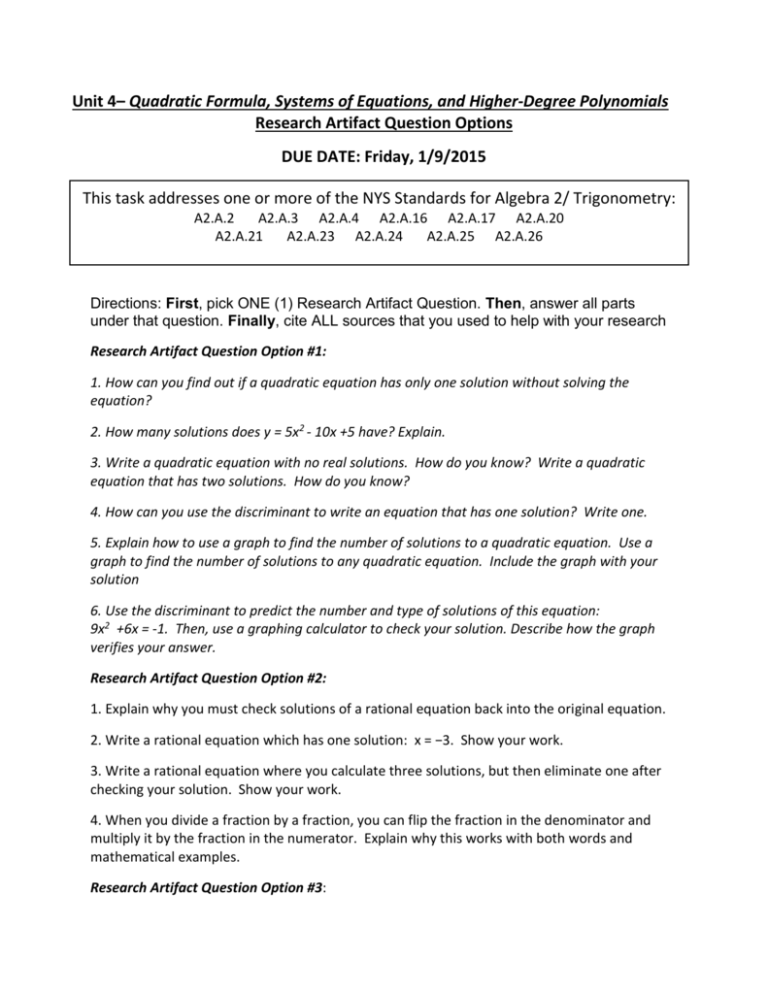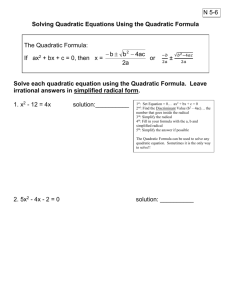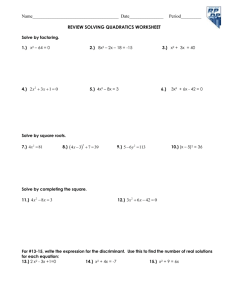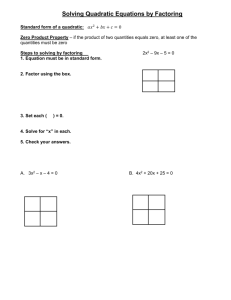Research Artifact Question Options
advertisement

Unit 4– Quadratic Formula, Systems of Equations, and Higher-Degree Polynomials Research Artifact Question Options DUE DATE: Friday, 1/9/2015 This task addresses one or more of the NYS Standards for Algebra 2/ Trigonometry: A2.A.2 A2.A.3 A2.A.4 A2.A.16 A2.A.17 A2.A.20 A2.A.21 A2.A.23 A2.A.24 A2.A.25 A2.A.26 Directions: First, pick ONE (1) Research Artifact Question. Then, answer all parts under that question. Finally, cite ALL sources that you used to help with your research Research Artifact Question Option #1: 1. How can you find out if a quadratic equation has only one solution without solving the equation? 2. How many solutions does y = 5x2 - 10x +5 have? Explain. 3. Write a quadratic equation with no real solutions. How do you know? Write a quadratic equation that has two solutions. How do you know? 4. How can you use the discriminant to write an equation that has one solution? Write one. 5. Explain how to use a graph to find the number of solutions to a quadratic equation. Use a graph to find the number of solutions to any quadratic equation. Include the graph with your solution 6. Use the discriminant to predict the number and type of solutions of this equation: 9x2 +6x = -1. Then, use a graphing calculator to check your solution. Describe how the graph verifies your answer. Research Artifact Question Option #2: 1. Explain why you must check solutions of a rational equation back into the original equation. 2. Write a rational equation which has one solution: x = −3. Show your work. 3. Write a rational equation where you calculate three solutions, but then eliminate one after checking your solution. Show your work. 4. When you divide a fraction by a fraction, you can flip the fraction in the denominator and multiply it by the fraction in the numerator. Explain why this works with both words and mathematical examples. Research Artifact Question Option #3: 1. Explain how to use the quadratic formula to solve a quadratic equation. Include an example. 2. Write the keystrokes you use to find one solution of using the quadratic formula and a calculator. (Plug into the quadratic formula. Write out the calculator buttons you push to calculate.) Is the solution rational or irrational? What does it mean to be rational or irrational? 3. Suppose you cannot factor about b? into the product of two binomials. What can you say 4. a. Write two different quadratic equations which have the solutions b. Find the product and sum of the roots from 4. a. ( ) by first adding the roots (for sum) and multiplying the roots for the product, then using the product and sum formulas. Why do these formulas work? Research Artifact Question Option #4: 1. Make up your own quadratic equation. Solve it by completing the square. 2. Write a quadratic equation that has only one solution and can be easily solved by completing the square. 3. How can completing the square help write a quadratic equation in vertex form, which is f (x) = a(x - h)2 + k? 4. Make up a quadratic equation: Solve it by factoring, Completing the Square, and by Using the Quadratic Formula. 5. Make up another quadratic equation where it cannot be factored. Solve it by both Completing the Square and by using the Quadratic formula. 6. Decide: What situations is Completing the Square easier? What situations is using the quadratic formula easier? What situation is factoring easier? Show examples of each.








